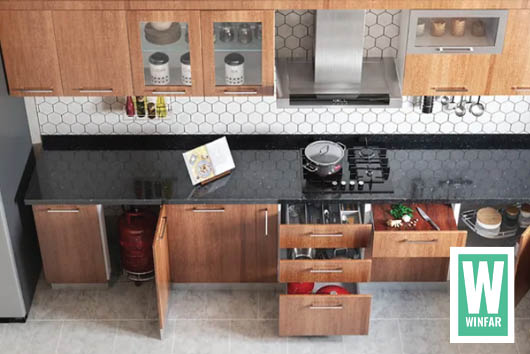Most of us don’t have a wishlist budget on hand to simply overhaul at whim. And overhauling a kitchen can be an expensive exercise. So what can we do practically, now, to ensure your senior stays independent and safe?
New Life Bath & Kitchen shares some simple changes, that can make a world of difference.
1. Lighting
A well-lit kitchen is a safe kitchen, especially for senior citizens. With deteriorating eyesight, working with knives and hot appliances can be hazardous.
- Easy to find light switches: So first things first, ensure all light switches are easy to find and accessible. If necessary, color code which light switch is for which room.
- Easy to use light switches: Use light switches that are easy to turn on and off. Where possible replace any regular light switches with rocker light switches. These work for the whole hand and are easier to use than traditional switches.
- Switch to LED: Replace old bulbs with LED lights. LED is a softer light and easier on the eyes.
- Countertop lighting: Then, take inventory of the current lighting in the room.
You want to ensure the countertop workspace is as well-lit as possible.
Natural light, as well as a combination of ceiling, sink and countertop lights, will help the elderly spot and access items better. So, wherever possible, Install countertop lighting above workstations, below upper cabinets, and in storage spaces.
2. Easy access storage
Stand in the kitchen and critically access the workspace,
Ask yourself one question: What can you do to simplify this kitchen?
Simplicity and ease of access are the two driving considerations when it comes to kitchen safety.
Deep cupboards, with frequently used items buried at the back, are a problem. So start there:
- Open shelves: Add some simple, easy mount, open shelves, below the top cabinets, to store frequently used items like spices and cooking vessels. Open shelves are easy to access and make things easy to find.
- Hang them up: Don’t bury spatulas, plates, and spoons in deep drawers, bring them out and hang them on hooks, racks, and holders.
- Pull-out drawers: Where possible, insert pull-out drawers, with trays into the deeper cupboards.
Pull out drawers and trays enable hassle-free access.
It’s much safer for older adults to be able to pull shelves toward them instead of having to crouch down to search inside a lower cabinet or using a step stool to reach items in higher cabinets.
Spring-assisted shelving can also help with heavy items. - Easy to reach: daily-use items, like cookware, should be in the lower cabinets, and easier to reach. Even if a wheelchair isn’t being used, place these items between waist and shoulder height.
3. Wall-mounted appliances
- Wall-mount the microwave, and other frequently used appliances.
Wall-mounted appliances are easier to access, and thus easier to use – whilst freeing up counter space at the same time. The less clutter, the less likelihood of accidents. - When purchasing appliances, always look for those with large or easily discernible buttons and displays. If your adult struggles with deteriorating eyesight, you want appliances that are as easy to read and use as possible
- And remember to install easily accessible electrical switches!!
4. User-friendly drawer handles
- Round pull knobs can be difficult for an arthritic hand to handle. Replace any pull knobs with wider D-shaped draw pulls. If you have extra budget, you might consider a touch drawer system, where the door simply pops open when pushed.
5. The kitchen sink
The sink is obviously a hub of kitchen activity, so you want to keep it as user-friendly as possible.
- Ensure the taps are easy to reach and easy to use.
- Opt for lever-style fixtures where possible, instead of twist knobs. as they are significantly easier to use, especially for arthritic hands. Sprayer attachments are another useful option, especially handy when washing dishes.
NOTE: Make sure your geyser water temperatures are set to lukewarm and not scalding hot.
6. Countertops
For those with limited vision or dementia, colors and labels can be incredibly helpful. Contrasting colors specifically, make things easier to see!
If you have a choice, choose a countertop that is a different color from the cabinets. If you don’t, you may need to be a little creative, using a colour tape or tile to create a counter edge of a different shade. The colour demarcation makes it easier for weak eyes to spot things.
TIP: A simple way to make sure the stove knob isn’t left in the on position is to put red nail polish or a colored tape on the “off” position. This also makes it easier for your older adult to check that it’s off without having to walk across the room.
If possible also consider rounded edges rather than sharp corners for your kitchen cabinets.
And opt for quartz or granite as they are easy to clean and maintain
7. Add a work table
While lowering countertops may be the stuff of wishlists, an inexpensive alternative may be to purchase a 30-inch-high corner table or kitchen island. A standard counter height is 36 inches, inaccessible for anyone in a wheelchair. A 30- inch island would create a comfortable workspace for anyone in a seated position. It should fit a wheelchair underneath and still be at the right height for food preparation.
8. Safe Floors
The floor can be easily overlooked, and yes it’s probably the most painful and expensive change to make. If you have vitrified tiles or marble flooring, the risk from falls should not be taken lightly. Anti-skid flooring will give elders a better grip while walking, and won’t cause mishaps even if they use a walker. Whatever you do, do not use throw-down mats and loose rugs, they are an accident waiting to happen. You can consider interim options like carpet tiles and cork, but they must cover the entire area, with no ridge or join, so there is no possibility of the foot hooking and tripping.
SOURCE:
https://www.livspace.com/in/magazine/kitchen-for-senior-citizens
Https://dailycaring.com/ – 6-affordable-ways-to-create-a-senior-friendly-kitchen
DISCLAIMER: This website does not provide medical advice. This information, including text, graphics, images, and other material contained on this website is for information purposes only. No material on this site is intended to be a substitute for professional medical advice, diagnosis, or treatment. Always seek the advice of your physician or other qualified health care provider with any questions you may have regarding a medical condition or treatment before undertaking a new health regime, and never disregard professional medical advice or delay in seeking it because of something you have read on this website.

